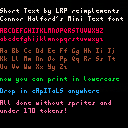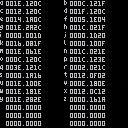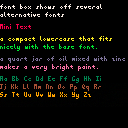A while back, RhythmLynx posted a couple lowercase fonts that tried to use as little sprite space as possible. I had a lot of fun trying to pack the characters into overlapping regions on the sprite sheet to use even less sprite space.
But, recently I had an idea to skip the sprite sheet entirely and define each character as binary data that can be stored as a number in a table. This is the result. Press z to swap between demo text and a reference guide. The reference guide is stored on the sprite sheet, but is not used for the lowercase print function.


Some explanation hidden...
Even though this method can store 4x8 characters, I only needed a 3x7 space for this font. I originally had a method that allowed me to store two characters per number, but the extra tokens necessary to handle the multi-letter storage outweighed the tokens gained by shortening the array.
The final approach is more flexible and could be used to swap in any custom font, maybe even m7kenji's kana font.
Small Text also allows you to force a default character by inserting a backslash before the character. Be careful: the backslash also has to be escaped, so your string has to look like "\e" to draw a capital E.

It's all looking pretty good. What you might shoot for is a font that is 3x7. You'll have the added 2-extra pixels and get your lowercase characters in a 3x5 field where they are much more legible.
Here is one I'm working on:


Ha, from 2 sprites to 0! This is really cool, it's especially nice that you can easily drop capitals in wherever you want. Reference guide is very useful too, good explanation. I'm curious what your method for storing two characters per number is?

dw817: I like where your font is going!
RhythLymx: Each of these characters (with one exception) is actually only 3x5 pixels. Some happen to be positioned higher or lower than others. Storing 3x5 pixels takes 15 bits, and one more bit indicates whether to start drawing from the top line or shifted down two pixels. That's 16 bits per character, so you can fit exactly two characters per lua number. The exception I mentioned is "j", which is six pixels high. This could be redrawn to fit into a 3x5 box, but I originally just had a special exception that could treat that character as 2x7 instead of 3x5.


And here's the utility that I used to figure out the data for each character.


- Open this cart in pico-8.
- Draw the characters you want into the sprite sheet. Each character occupies half of a sprite (4x8 pixels).
- Run the cart to see the hex values for each character. Cycle through each row of sprites with the up/down arrows.
- Take a screenshot or something to save the hex values.
- In the font box cart (or your own cart with these font libraries), set a string variable containing all the characters in your font.
- Make a table with the hex values of each character. Make sure the order of the character table matches the order of the letter string.
[Please log in to post a comment]








